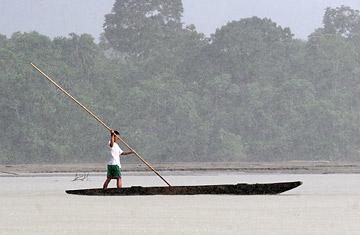Stephan Küffner
Rain Forest Tribesmen Just Want to Be Left Alone

Nine ironwood spears protruded from the lifeless body of Luis Castellanos when it was found in March, near a jungle road. Castellanos, 37, was the third poacher of rare woods murdered in this remote patch of eastern Ecuador since 2005. And the prime suspects in the killings, say officials, are the ferocious warriors of the Tagaeri and Taromenani tribes — primitive and virtually unknown groups who cling to their Stone Age lifestyles deep in the Amazon rain forest, and appear determined to remain "uncontacted" by modern civilization.
Most of South America's previously isolated indigenous tribes, like the Yanomami of Venezuela, acquiesced to contact with the outside world a few decades ago. But Ecuador's tiny Tagaeri and Taromenani communities are among the last holdouts, whose xenophobia creates a dilemma among advocates for indigenous rights. "At most, there are 400 of them left," says Eduardo Pichilingue, head of the Environment Ministry team trying to protect the tribes.
Because their immune systems are almost certainly unable to cope with exposure to common diseases, contact with anyone from tourists to nearby rival tribes could wipe them out in one brief and devastating epidemic — as the first contact with Europeans did to millions of indigenous across the Americas after 1492. But any move to vaccinate them will end their traditional way of life. Already, the Tagaeri and Taromenani are having to defend their hunting grounds against illegal loggers, smugglers and settlers moving into their midst, together with the oil companies that are drilling ever closer to what is supposed to be an "untouchable" ecological zone. Says Pichilingue, "It's a race against the clock."
The tribes survive as they've always done, on hunting, fishing, and cultivating manioc in isolated fields cleared from the virgin forest. They are certainly aware of the outside world, but they want no part of it. The Tagaeri are actually a breakaway from the Huaroani, a group of 2,200 people who 35 years ago became the most recent tribe "contacted." Many Huaroani today work for oil companies or tourism companies, although some also work with the loggers who are destroying the forest. When the Huaroani made their peace with modern Ecuador, a faction — the Tagaeri — broke away and retreated into the rain forest, enlisting men and women from several Huaroani families and setting the stage for a bloody conflict.
Egged on by loggers and poachers, nine Huaroani in March 2003 sought to avenge a Tagaeri "kidnapping" by massacring up to 30 forest dwellers, including women and children burned to death inside a homestead. But the dead weren't Tagaeri; they were the hitherto unknown Taromenani, a group that had moved into the jungle building abandoned by the Tagaeri that can house up to 60 people. While the Tagaeri essentially share the culture of the Huaroani, the Taromenani have distinct, serrated hour-glass-shaped spears and cut their hair shorter. According to the Huaroani, the Taromenani speak a different, although vaguely related language. And they appear to be fascinated by the outside world: Their spears are wound in plastic string and they wear necklaces decorated with bottle caps and small metal plates taken from debris floating downstream. They steal machetes and axes from tourists and loggers. "If it weren't for the massacre, they'd probably have been contacted by now," says Franziska Mueller, a Swiss tour guide working near the contested Shiripuno River area and the first non-indigenous witness to the bloodshed. Huaroani warriors returning from their 2003 raid proudly showed her the severed head of a Taromanene they had killed.
Ecuadorian authorities have done little to stop the killings or the encroachment of the modern world into the last refuges of these "uncontacted" people. The government of President Rafael Correa has declared the largely untouched southern part of the Yasuni National Park a no-go zone, but the administrative borders mean little to where the tribes roam. Castellanos' body was found in an area known as Armadillo, well to the west of any protected area and currently being developed for oil extraction.
Pichilingue says the government plans to establish five outposts equipped with boats and satellite phones and staffed with police and scientists to help keep developers and poachers out of the no-go zone. Oil companies have agreed to control access to their own zones, and to vaccinate their workers to avoid contagion in case of accidental contact. Activists say, however, that such steps are too late, given the booming trade in smuggled wood.
"There's no sign that the political will for conservation could be stronger than the desire to exploit hydrocarbons, mining, or forestry in Ecuadorian Amazonia," says Milagros Aguirre, an author specializing on the area. She advocates strict control, including proof of vaccination of everyone living or working in the area. But such are the stresses on the traditional lifestyle of the Tagaeri and the Taromenani in competition with modern society's hunger for resources that chances of a happy ending appear to be slim.
